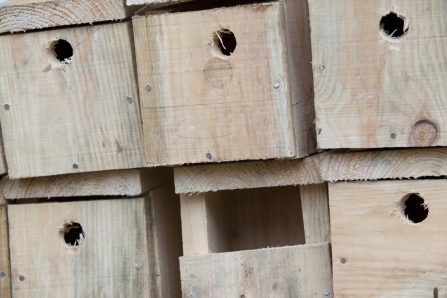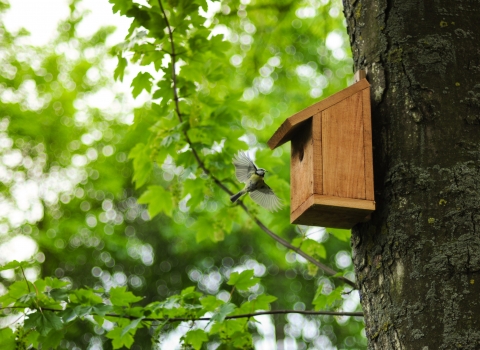Getting started
Gardens are a most important habitat. The total area of all gardens in Britain exceeds that of all nature reserves, and as modern lifestyles destroy trees, hedges and old buildings, natural nesting sites are in decline.
Nest boxes placed in gardens can make a real difference to the success or failure of a breeding species in a given area, especially when accompanied by the regular supply of suitable food and water.
Design
There is no standard, accurate design for a nest box. Birds do not insist on their nest sites being mathematically precise! What they do require is a nest site which is secure and weatherproof, and as safe as possible from predators.
Different bird species favour different types and locations of nesting sites, and so boxes must be constructed accordingly to meet these different needs. Two basic designs however will accommodate most common garden birds; either a partly open-fronted box, or a box with a circular hole at the front (of varying diameter for different species).
Dimensions need not be precise; make the box to suit the materials available rather than buying materials to match any given dimensions.

© Peter Cairns/2020VISION
Materials
Undoubtedly wood is the best material to use; new or old wood, rough or planed, softwood or hardwood - it is really not important. Use what is readily available. A thickness of about 0.75inches is ideal.
Manufactured board (plywood and chipboard) are not suitable for outdoor use (except for resin-bonded marine quality ply, which can be expensive), although they are perfectly acceptable for a nestbox placed under cover, for example a Barn Owl box placed in an old building.
After construction, the outside only of the box should be treated with a water-based wood preservative product such as 'Cuprinol' or 'Sadolin', (NOT creosote) to prolong its life and help repel water. If using planed timber, clear polyurethane may be used instead. All boxes should be treated annually in this way and allowed to dry thoroughly before being erected. A piece of roofing felt fixed to the roof will also prolong the life of the box and render it more waterproof.
Positioning your bird nestbox
For nestboxes with open fronts and small entrance holes:
Height
Whether fixed to a tree or a wall, the height above ground is not critical to most species of bird, so long as the box is clear of inquisitive humans and prowling cats.
Aspect
If there is no natural shelter, it is best to mount a box facing somewhere between south-east and north, to avoid strong direct sunlight and the heaviest rain. The box should be tilted slightly forwards so that the roof may deflect the rain from the entrance.
Predators
It may be possible to deter predators by fixing the nestbox in a thorny bush or by placing chicken-wire around the entrance, but always ensure a direct flight-path to the entrance. If squirrels or woodpeckers are a serious threat, fix a metal plate around the entrance, so that it can not be enlarged.
Fixing
Some authorities recommend nails to attach the box directly to a tree trunk or branch; others prefer the use of rope or wire right around the box and trunk (remembering to protect the trunk from wire cutting in by using of a piece of rubber or similar). Both methods are satisfactory, but obviously annual maintenance is easier if the box is wired and can thus be taken down easily for cleaning.
Number
The number of nestboxes which can be placed in a garden depends on the species you wish to attract. Many species are fiercely territorial, such as Blue Tits, and will not tolerate another pair close by. About 2-3 pairs per acre is the normal density for Blue Tits. Other species such as Tree Sparrow, which are colonial nesters, will happily nest side by side.
Do not place any nestbox close to a bird-table or feeding area, as the regular comings and goings of many other birds are likely to prevent breeding in the box.
Cleaning
After the end of each breeding season, all nestboxes should be taken down and the old nesting materials removed, and the box should be scalded with boiling water to kill any parasites. Do not use insecticides or flea-powders - boiling water is adequate. Annual cleaning is best carried out in October or November.
Under the terms of the "Wildlife and Countryside Act 1981", if unhatched eggs are found in the box, they can only legally be removed from October to January inclusive, and they must be destroyed! It is illegal to keep them.
Winter
Leave the bird box up in winter as it will be useful as a roosting site for birds in bad weather.
Feeding
Putting up a feeder or table is one of the easiest way to attract birds to your garden, especially during the winter months when food is harder to come by.
Who eats what
| Mixed seeds | Blackbird, blue tit, chaffinch, collared dove, dunnock, greenfinch, house sparrow, robin, song thrush |
| Niger seeds | Goldfinch, siskin |
| Black sunflower seeds | Blue tit, chaffinch, collared dove, goldfinch, great tit, greenfinch, house sparrow, siskin |
| Sunflower hearts | Blackbird, blue tit, chaffinch, goldfinch, great spotted woodpecker, great tit, greenfinch, house sparrow, long-tailed tit, robin, siskin, song thrush |
| Suet or fat balls | Blackbird, blue tit, coal tit, dunnock, great tit, long-tailed tit, robin, starling, wren |
| Peanuts | Blue tit, chaffinch, collared dove, dunnock, great spotted woodpecker, great tit, greenfinch, long-tailed tit, siskin |
| Mealworms | Blackbird, blue tit, great tit, house sparrow, long-tailed tit, robins, song thrush, starling, wren |
| Fruit | Blackbirds, fieldfare, redwing, robins, waxwings |




